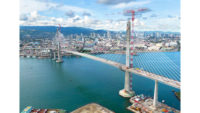Tower cranes rising more than 320 ft above a valley floor in Germany are being used to build a multi-span cable-stayed bridge that will relieve the small town of Horb am Neckar of heavy through traffic.
Originally due for completion in 2026, an accident during a large concrete placement will likely affect the schedule of the project, about 30 miles southwest of Stuttgart.
The 2,188-ft-long structure is being built by Porr Group, an Austria-based contractor that ranks at No. 63 on ENR's current Top Global Contractors list. It has a $125-million design-build contract awarded in late 2022 by the owner, the Karlsruhe Regional Council.
Locally based Leonhardt, Andrä und Partner is the contractor’s designer, having undertaken studies and supported the owner in project procurement between 2016 and 2021.
The bridge will have six spans, ranging from about 197 ft to 518 ft, crossing up to 230 ft above the Neckar River valley floor. Three central piers will rise in V-profiled pylons up to 295 ft, from which cables will radiate down to support the haunched continuous concrete deck edge girders.
Because the longest span would not warrant a cable-stayed design, and a simple beam structure would been aesthetically unacceptable, the designers went for an extradosed option with low towers, says Holger Haug, director of locally based Leonhardt, Andrä und Partner (LAP), which is the contractor’s designer.
The cables help support the deck's edge girders, which are continuous over the whole bridge, explains Haug. Partly for ease of construction, the girders, which are up to 15 ft deep and generally around 6.5 ft wide, are being massively cast in solid concrete.

The edge beams support steel box cross girders, which are about 5 ft deep. These are covered with precast concrete formwork slabs and topped with a 10-in. cast in place deck.
The contractor has deployed two free standing cranes on 316-ft- and 331-ft-tall towers to serve construction crews. Tying them into the bridge would have been "disproportionately complex and expensive,” according to the supplier Wolffkran.
So far, the first span on south side is complete and the contractor is preparing to start casting the next one on its launcher, three to four months behind schedule.
Time was lost following a falsework failure in February while the contractor was pouring the 36-ft-long lower cross girder between the legs of the first main pier about 82 ft above ground.
Bolts holding the formwork of the 5.9-ft-deep girder to the pier legs failed, causing no reported injury but ruining the pour. The affected crossbar has since been replaced with no impairment to the structure, says Haug.
Contractual implications of the incident are under review, notes the owner. But that does not dent Haug's pride in the viaduct's design. "We are doing a lot of special bridges all over the world, " he says. "This is one of our outstanding structures."





